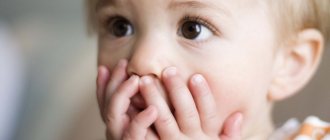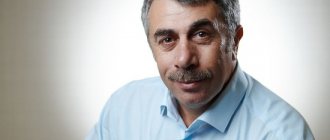About neurological norms
Why is it believed that children should speak at two years of age?
There are neurological norms based on physiological data. Neurological criteria were developed taking into account the stages of brain development. A child begins to walk when, at the age of one to one and a half years, the motor functions associated with upright posture, including the cerebellum, are activated. Movement disorders can also lead to developmental delays. Speech, as the highest function of the brain, depends on the development of almost all its parts. But two departments are especially important:
- Broca's area;
- Wernicke's zone.
Broca's area in the brain is responsible for speech reproduction - the child learns to speak by repeating after those around him. This is a motor function that is of great importance for a child's development. Wernicke's area is responsible for understanding speech; it is a sensory function. Both areas are activated before the age of 2, which corresponds to the norms of child development. Activation may occur late (this is not a violation, although it occurs quite rarely), and the child may speak independently. But there is always a risk of more severe violations.
Speech development. How to understand that there is a violation
According to statistical data, 10-15% of children aged 2-3 years have delayed speech development. By the age of 4, the disorder persists in only 4-5% of children. Later, the problem remains mainly in children who have concomitant pathologies (for example, Down syndrome or autism). However, the term is used by specialists (speech therapists, psychologists, pediatricians, neurologists) very often and sometimes completely unfoundedly causes parents to become alarmed.
How to understand that there is a violation
We speak of delayed speech development if 90% of children of the same age have mastered a skill characteristic of this age, and an individual child has not even come close to mastering it. For example, a one-year-old child does not respond to spoken speech and does not make any sounds. In this case, the diagnosis “delayed speech development” is also valid; it’s not just a matter of “speaking.” However, you should not draw conclusions on your own; it is better to trust a qualified specialist. You need to see a doctor if:
- a baby under 6 months does not respond to sounds or calls from parents;
- a child aged 6-9 months does not make any sounds;
- a one-year-old baby does not say the words “mom”, “dad” or any other simple phrases or syllables to call them;
- a child aged 1.2-1.3 years does not use words other than those denoting parents to express his desires;
- the child does not use any gestures regarding the objects he wants to take;
- a one and a half year old child uses less than 5 words or their sound equivalents in his speech reserve;
- the child does not react and does not involve loved ones in reacting to significant events (joyful or surprising);
- at 2 years old, the baby does not use simple phrases (for example, “I came,” “hello, mom,” “good cat,” etc.), while a combination of vague words is allowed, it is important that they contain the essence.
In the listed criteria, the terms can be called conditional. You can safely add a month to them, since sometimes this time plays a decisive role, and the skill is successfully formed.
How to clarify the situation
To determine the severity of the problem, parents need to try to clearly answer the following questions:
- Are the problems only with speech or can they be traced in other areas (anxiety, strange behavior, excessive activity)?
- Is the level of intelligence appropriate for the child's age?
- Does your baby use nonverbal communication methods?
- Does the child have symbolic thinking abilities? Does he play with toys?
- Does your child have difficulties with speech perception? Does he respond when contacted?
Positive answers to all questions except the last one indicate an isolated speech delay (not associated with diseases). 60% of such children “catch up” with other children in terms of speech development. Parents can help them on their own. After 4 years of age, isolated impairments are rare, and developmental delays are most likely due to medical conditions.
What should and should not be done?
If speech problems are confirmed, parents need to concentrate on solving them, and not looking for those “to blame.” To do this you should:
1. Check with age standards for the main milestones in the development of speech abilities.
2. Have the child’s hearing checked by an ENT specialist.
3. Contact a neurologist.
When choosing a pediatric neurology specialist, you should pay attention to his approach. A doctor should not immediately prescribe nootropic drugs or offer treatment with innovative devices until he understands the essence of the problem. It would be right for parents to gently outline the task that they assign to the specialist (they need to rule out autism or diseases that may be the cause of speech disorders and generally assess the situation). It's also worth remembering what not to do:
- Fall into a panic, compare your baby with others, discuss the problem in his presence and focus on how bad everything is.
- Look for pills from the “to make you talk” series. There are no drugs with proven effectiveness for this purpose, and dubious drugs may be unsafe.
- Use alternative medicine methods.
- Conduct research (rheoencephalography, EEG).
- Do massages in order to “start speech”.
- Endlessly take your child to doctors, healers and shamans.
How to get a child to talk?
Most often, parents just need to calm down and give their baby time. In 96% of cases, the problem is solved on its own, with the help of adults. To help a non-verbal child gain speech skills, you can:
- Make an appointment with a speech therapist. It is advisable to find a specialist who knows logomassage. Tactfulness in dealing with children's problems and the ability not to interfere in other areas are welcome.
- Develop the baby physically. Outdoor games and toys that promote the development of fine motor skills will also have a beneficial effect on speaking skills.
- Create a rich linguistic environment. Parents should talk more with the baby and in his presence. Conversations, comments, poems and songs on any topic are welcome.
- Read together. Any books are suitable. An abundance of pictures and thematic questions will help to captivate the child. When reading, you need to create a dialogue with your child.
- Reduce spending time with gadgets. Games and cartoons can replace a child’s real learning process, which requires effort from him.
- Involve your child in conversations. You should ask his opinion, give him the right to choose, find out about where and how he spent his time, what emotions he experienced (even if the baby does not respond).
In the process of child development, parents should not forget about themselves. They also need sources of positive emotions and inspiration, adequate sleep and nutrition. Otherwise, adults simply will not have enough strength to solve the child’s problems.
Consequences of developmental delay
Parents who expect their child to speak by age 3-4 should understand that lack of speech can lead to various disorders:
- mental retardation;
- ticks;
- psychological problems.
To eliminate developmental delays, neurological, psychological and speech therapy assistance is required. By age 7, a child should be ready for school. If therapy is not provided to a child, developmental delays can affect his entire future life.
“THE CHILD DOESN'T SPEAK. WHAT TO DO?"
Are such extreme measures always necessary? Of course not!!! However, an adult needs to create situations, encouraging the child to speak, pretending that he does not understand him. But here you need to know when to stop - it is important to encourage speech, and not to force!!! I’ll tell you about the methods of encouraging speech that I used in communicating with silent children and their parents.
Method 1. I call this method “Incomprehensible Adult.” Here is one example of using this method. Take one new bright toy and several old, unattractive toys (for a new one, you can use a toy that the child has not seen for several weeks, and he has already forgotten it). Place them so that the child cannot reach them himself (for example, on a shelf in a closet). “YYYYY,” says the child and points his finger at a new bright, attractive toy, tries to reach it, but cannot. An adult offers him an old, unattractive toy from this shelf. The baby tries to explain with gestures to the dull adult what he needs, along the way he begins to babble, he looks demandingly at the adult, and points his finger at a new toy. The adult clearly names the toy, for example, “kitty” or “Katya” (doll) several times, but does not give it. You can ask: “Should I give you some kitty?” Kisu? or “Should I give you a nesting doll? Say, give me, give me, matryoshka.” The child begins to look at the adult and listen to the word, tries to move his lips. Tries to pronounce a word. The adult once again gives a sample of the word, pronouncing it several times with a questioning intonation: “Kisa?” And often the child makes an attempt to speak! Or moves his lips. Then we say “together with him”, encourage him and give him a toy.
Note to mom:
1.This method will not work if:
- give the toy immediately, without encouraging speech and without showing patience,
- this toy is within the child’s access, and he can easily get it himself,
- the toy is already familiar to the child or is unattractive,
2. If a child does not speak and does not try to speak, but demonstratively stomps his feet, is capricious, bites an adult, scratches and even hits his mother (alas, I had to encounter such communication between mother and child) or uses other inappropriate ways to get a toy, then he is a toy do not get.
2. Here you need to be firm, but friendly and loving – i.e. the adult does not punish the child by not giving him the desired toy, but he simply does not understand him, but at the same time loves and supports him.
I had to use this method when working with a non-speaking 5-year-old boy (!!!). They lived together with their mother. The communication between this child and his mother was structured in such a way that the boy did not need speech - before he had time to raise his finger, his mother immediately gave him either a toy that he pointed at, or tasty food, etc. The child did not go to kindergarten. I watched a lot of TV at home (TV cannot be a child’s play partner and therefore does not stimulate speech in a silent child, but simply occupies him for a while).
How was the problem resolved? The boy was included in a mini-group of 4 talking children of the same age for classes with the condition - his mother should not be in class and under no circumstances should she enter the room where classes were held with children. I had to play the role of a “misunderstanding adult” who really wants to help the child, treats him well, but does not understand the child’s gestures. During classes, children drew, played musical instruments, did experiments, i.e. There were no special speech exercises. But situations were specially created in which the help of an adult was required - to get it, pass it, etc. At first, the child tried the methods of communication he had already learned - pointing his finger, humming. If he didn’t get what he wanted, he stomped his feet and shouted loudly. But I threw up my hands, looked at him sympathetically, and pretended that I didn’t understand anything. Then he realized that he “got it”!!! “It's time to change tactics! This aunt has a bunch of very attractive new items, but does not understand gestures at all!!! How then to get these items? And “the process began” :). First the first words. A month later, the child spoke immediately in phrases! After a month and a half, complex sentences appeared in his speech. Six months later he went to kindergarten, and a year and a half later to a regular secondary school. This method only works if the child does not have developmental problems. Because There are cases when the baby, even if he really wants to, is simply physiologically unable to repeat your word!
Method 2 – “Orders”. If a child “doesn’t want to talk,” then giving instructions often helps to get him talking. Ask your child to bring you the thing you need by asking your dad, grandma, or older sister for it. Say: “Daddy, give it,” you say to the baby. And the child runs to dad, wanting to help you. There is a motive to speak, which means there is a chance to stop being silent! Ask other family members to involve your child in similar tasks that require speech more often, and after a while you will notice changes in the child's speech.
Another common situation that is very suitable for an assignment is to ask your child to invite all family members for dinner, breakfast or lunch. Say - “Go, dad. Go, grandpa. Go, go." And the baby will run to fulfill the request, which means he will have a desire - a motive to speak. You can speak the words with him in chorus, sing them to the tune of the song.
Method 3 – “Agreement of syllables.” You say the first part of the word, and the child finishes the last syllable. You meet an older child from school and rejoice at him together with the baby: “Who has arrived?” ask a 2-year-old child. And help him with the beginning of the answer: “In...”. “Va,” the kid finishes, addressing his brother Vova, who came from school. Involve your child in this kind of finishing of words more often, and you will notice that after a while the baby himself will begin to pronounce these words without your help. With older children, you can also finish lines from simple poems.
Do not focus the attention of your family, friends, and the child himself on the fact that the child is 2 years old and does not speak. Moreover, do not laugh at him and do not lament in front of the baby. This will greatly help your baby speak faster. Just believe in him and in yourself and take action.
You will find what parents need to know about delayed speech development in children in the video “Delayed speech development in children. How to get a child to talk?
Delayed speech development of a child. Signs, symptoms and who to contact.
September 15, 2016
Speech begins to form long before the first words appear. Researchers of child speech establish significant periods in a child’s life (from approximately 0 to 14-16 months), which are called pre-speech and pre-speech periods. They are extremely important for the child’s further own speech and language development, since it is at this time that all his basic psychological and mental processes are formed.
The head of the speech therapy consultative and diagnostic service of the educational complex of State Budgetary Educational Institution Secondary School No. 875 in Moscow, speech therapist Osteopolyclinic, myofunctional therapist, developmental psychologist, candidate of psychological sciences Yulia Aleksandrovna Tisovskaya (Yulia Aleksandrovna graduated from Moscow State Pedagogical University named after Lenin, 20 years old) talks about the problems of delayed speech development in children works with children with severe speech impairments).
Speech is the highest mental function, therefore the period of intrauterine development of the child is also important. Often, perinatal developmental pathology is diagnosed too late (after 3 years), when the consequences of these disorders become obvious. The pre-speech and pre-speech periods are indicators of how speech will develop.
You need to contact a speech therapist if:
- there was intrauterine growth restriction
- hypoxia
- long stay in intensive care
- feeding through a tube in the first days or months of life
- CCH (craniocerebral hypothermia) at birth
- visual impairment
- hearing impairment
- genetic syndromes
- increased intracranial pressure (hydrocephalus)
- birth injury
P signs and symptoms , which together should alert and attract attention, but it should be borne in mind that if there are only 1 - 2 symptoms, we can only talk about the baby’s character and his characteristics, and not developmental disorders .
Ages 0 to 1.5 years
- by three months, the “revival complex” has NOT appeared - the child’s emotional reaction to an adult (the child, seeing his mother, squeals joyfully, moves his legs, throws up his arms, makes vocal reactions)
- humming (soft vocalization) appeared NOT at 2-3 months, but later; periods of humming are rare, sounds are quiet, monotonous, breathing is quickly exhausted, there is hoarseness of the voice
- the transition to babbling (multiple repetition of chains of syllables) occurred later than expected (normally, the period of babbling lasts from 5-6 to 12 months); • by the end of the first year of life, common words did NOT appear (“mom”, “dad”, “baba”, “give”, etc.)
- at the age of 7-8 months and later does NOT understand the meaning of individual words (mom, dad, names of surrounding household objects, toys, etc.), DOES NOT understand the meaning of simple requests (“Give mom a pen”, “Show your nose, eyes” and etc.)
- the child does NOT imitate the actions of adults (with toys, household items), does NOT repeat individual words after adults
- The child has difficulty developing basic chewing and swallowing skills. For example, if a one and a half year old child cannot chew and chokes even on a piece of apple
- If a child of any age has a constantly open mouth or increased salivation for no obvious reason (not related to tooth growth)
Ages 1.5 to 2.5 years
- the child actively reacts to the sound of the TV on, but does not respond at all to spoken speech
- does not respond to his name
- there is no pointing gesture (does not point with a finger)
- no motor imitation (does not repeat movements after parents)
- no articulatory imitation, onomatopoeia, does not address family, or repeats after you or cartoon characters, but does not use these words when communicating (echolalia)
- does not perceive your questions by ear, answers correctly only based on your articulation (watches your lips and your pronunciation)
- does not follow basic instructions (bring the ball, give it, on, etc.)
- looks away and does not follow the adult’s emotions
- does what he can with your hand (for example, takes mom’s hand and opens the door with it, takes a mug, turns on the TV, turns off the light)
- fear of new premises, changing the route of a walk, new faces (hysteria if you decide to go along a different street)
- stereotypical and repetitive nature of the game (may open and close doors for a very long time every day, knock on certain objects until you interrupt it, lining up objects in a row)
- Stereotyped and repetitive motor movements (shaking or clapping of hands or fingers, or complex body movements). For example, with strong excitement (joy, sadness), he begins to wave his arms like wings, very often walks on tiptoe
- does not express interest when seeing children, does not pay attention to them and does not play
- at 2 years old the child uses only a few individual words and does not try to repeat new words
- at 2 years of age, the active vocabulary is less than 20 words and phrases. Does not know the names of surrounding objects and body parts: cannot, upon request, point to a familiar object or bring something out of sight. If at this age he cannot form two-word phrases (for example, “give me some water”)
Ages 2.5 to 3 years and older
- He speaks so incomprehensibly that even his family has difficulty understanding him. Does not speak simple sentences (subject, predicate, object), does not understand simple explanations or stories about events in the past or future
- the child “rattles”, speaks too quickly or extremely slowly, swallows the endings of words, stretching them out, although there is no example of such speech at home
- speaks mostly in phrases from cartoons and books, does not construct his own sentences - this is a sign of a serious developmental disorder
- mirrors what adults say in front of him, even out of place - this is the reason for an urgent visit to a specialist, and a psychiatrist at that!
- the mouth is constantly open or there is increased salivation for no obvious reason (not related to tooth growth)
Unfortunately, most parents often do not pay due attention to these symptoms and only difficulties in communication that arise in the future, and non-compliance with age development norms of 2.5 - 3.5 years, force them to pay attention to problems in the child’s development. For some reason, many specialists in clinics still send mothers and children to wait for 3 years and do not make any specific diagnoses, when in turn mothers complain that the child at 1.5 - 2 years old does not speak, does not understand spoken speech well, does not respond to his name , doesn’t point fingers, doesn’t make eye contact, doesn’t follow basic instructions, isn’t interested in toys? Three years is considered the optimal age, when approximately all children have developed a vocabulary and have an understanding of themselves in this world. Before this age, some develop faster, some slower.
But why, knowing about such complex diagnoses as early childhood autism, sensory and motor alalia, autism spectrum disorders, speech and mental development delays, sensory hearing loss, is it important to prevent and correct these disorders - therefore, a visit to a speech therapist in the first years of a child’s life is a necessary event. It is important to use a timely, comprehensive approach to correct speech impairment and understanding of spoken speech, which is aimed at speech activity, non-verbal higher mental functions and the emotional and personal side of children’s development at the very first stages of the problem.
SURVEY
What should you do if you find that your child has the behavioral characteristics that we have discussed, such as lack of speech, eye contact, pointing, understanding of addressed speech, joint activities, reaction to his name, etc.? We take the second Step: Survey.
Pediatric neurologist and EEG
Contact a pediatric neurologist; for many, the best option is a specialist in the neurological department of a children's hospital or specialized center. If you are told to “wait until 3 years”, look for another doctor who will prescribe a daytime or nighttime EEG (an overnight study allows you to exclude epileptic and convulsive readiness, which may not manifest itself in the form of seizures, but slow down the baby’s development), and recommend contacting an audiologist , undergo CVEP and audiometry.
Remember - there are many diagnoses and what can help with alalia can harm with sensorineural hearing loss or autism, which means the approach to each child must be individual.
Audiologist
Even a slight decrease in a child’s hearing can negatively affect speech development. Hearing impairment can be either temporary or permanent.
There are cases when one of the ears hears poorly, overall audibility is reduced, or the child cannot distinguish between certain frequencies - he hears loud and quiet ones, but not the middle ones. Because of this, the child perceives surrounding sounds as if he were under water. At the same time, he can react absolutely correctly when the TV is turned on and completely ignore your speech. Also, sometimes hearing loss occurs after the baby has learned to speak.
A child with undetected hearing loss will not be able to develop speech, language skills, and cognitive abilities properly and will show signs of delayed mental and speech development. The delay may be irreversible and the child will need to attend a specialized school. In medical practice, there are cases when a child with congenital hearing loss was diagnosed with mental retardation.
Many maternity hospitals use otoacoustic emissions, which provide information about whether the hair cells involved in sound transmission are working. But the positive result of this study does not yet provide a 100% guarantee that the child’s hearing is fine, because sound transmission requires the work of several parts.
Computerized audiometry may be needed - SSEP (short-latency auditory evoked potentials) - this is a study of the response of the brain stem and auditory nerve to sounds. KSEP is used to diagnose hearing disorders in both children and adults, but they are of particular importance in children, especially those of prelingual age. It is produced using sensors attached to the head. Allows you to determine not only the presence/absence of pathological abnormalities, but also the location of their localization. In most regions it is carried out while the baby is sleeping.
Basic recommendations of a defectologist for children from one to 2 years of age:
- formation and development of understanding of addressed speech (speak clearly, use situations that encourage simple actions: give, bring, look, etc.)
- formation and development of visual memory and concentration (the presence of a TV and, as a consequence, a constant background noise and passive reception of information interfere with the development of speech)
- formation and development of thinking (training the skill of obtaining information from books (audio tales) and stimulating role-playing games. That is, read, read and read, despite the fact that your child closes the book and does not sit still)
- formation and development of speech skills (actively use situations that encourage the pronunciation of simple words: na, yes, no, etc.)
- development of communicative communication (communication with peers)
The article is located in the sections: REHABILITATION AND RESTORATION, Speech Therapy and Defectology







